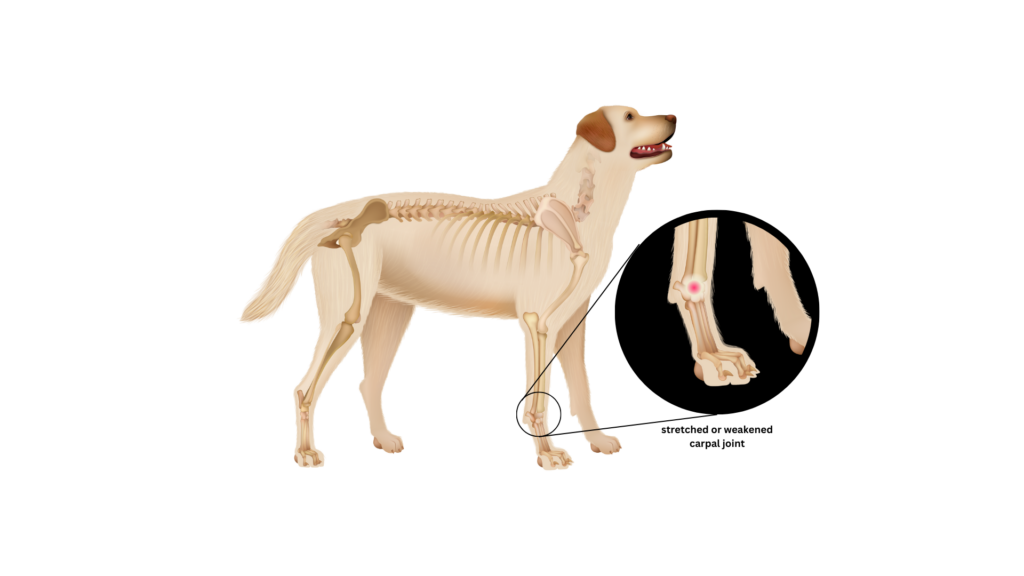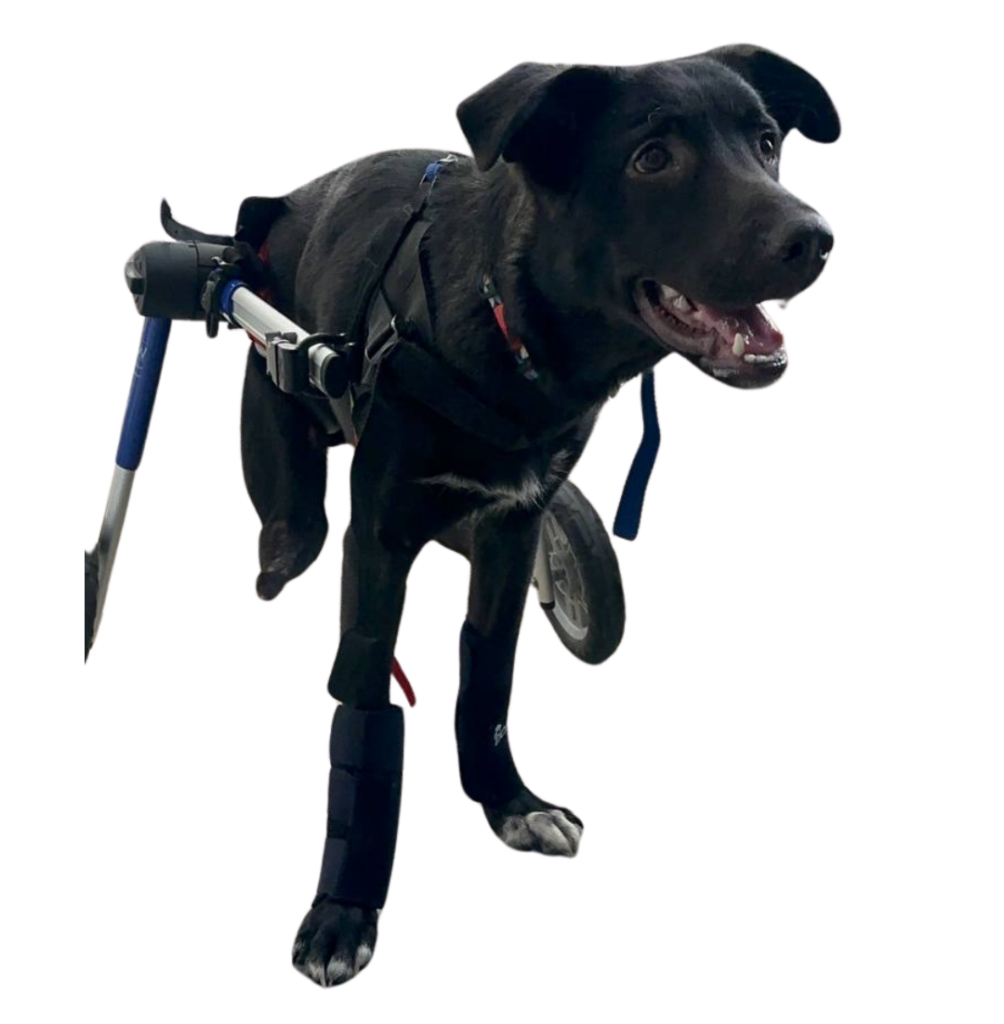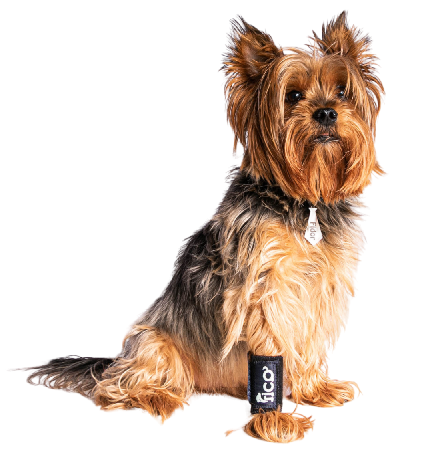Carpal Hyperextension
Canine carpal hyperextension is a condition where a dog’s carpal joint (the equivalent of the human wrist) becomes excessively stretched or weakened, causing the paw to collapse downward. This abnormal movement results in a noticeable deformity, where the dog’s lower leg appears to bend excessively at the wrist, leading to instability and difficulty in movement. It can affect one or both front limbs and is often seen in active dogs, senior dogs with degenerative joint issues, or those recovering from trauma.
The carpal joint plays a crucial role in a dog’s mobility, as it acts as a shock absorber and stabilizer while walking, running, or jumping. This joint consists of small bones, ligaments, and tendons that provide flexibility and support for proper weight distribution. When hyperextension occurs, the weakened ligaments fail to hold the joint in its natural position, leading to pain and difficulty bearing weight. Dogs with this condition may limp, struggle to stand, or show reluctance to move. Treatment varies depending on severity and may include splinting, physical therapy, or surgery to restore function and prevent further damage. Early diagnosis is key to ensuring a better quality of life for affected dogs.
Common Causes of Carpal Hyperextension in Dogs
According to Queensland Veterinary Specialists, Carpal hyperextension in dogs can result from various factors that weaken or damage the ligaments responsible for joint stability. One of the most common causes is trauma or injury, such as falls, jumps from high surfaces, or accidents that put excessive strain on the carpal joint. When the ligaments are overstretched or torn, they can no longer support the joint, leading to hyperextension.
Another contributing factor is degenerative conditions, particularly in older dogs. Over time, wear and tear on the ligaments and cartilage can lead to joint instability. Conditions like arthritis can weaken the supportive structures of the carpal joint, making it more prone to hyperextension.
Certain dogs may also have a genetic predisposition, especially large breeds like Labrador Retrievers and German Shepherds. Some breeds are born with weaker ligament structures, making them more susceptible to developing this condition over time, even without prior injury.
Additionally, underlying health issues such as autoimmune diseases, infections, or neurological disorders can impact joint health and stability. Conditions that weaken the connective tissues or affect nerve function may contribute to ligament laxity, leading to carpal hyperextension. Identifying the root cause early can help in managing and preventing further complications.

Signs and Symptoms: How to Tell If Your Dog Has Carpal Hyperextension
Carpal hyperextension in dogs is often easy to spot due to the visible signs of weakness and instability in the front legs. Affected dogs may stand with their wrists abnormally bent downward, creating a “collapsed” appearance. This condition prevents proper weight distribution, making movements awkward and unstable.
Another key symptom is limping or difficulty walking. Dogs with carpal hyperextension may struggle to bear weight on the affected limb, leading to an uneven gait. They might hesitate to run, avoid jumping, or show reluctance to play due to discomfort. In severe cases, they may completely refuse to put pressure on the injured leg.
Owners may also notice swelling or pain around the carpal joint. The affected area might appear inflamed, tender to the touch, or warm. Dogs experiencing pain may lick or chew at their wrists in an attempt to soothe discomfort. If left untreated, the condition can worsen, causing chronic pain and further mobility issues.
Early detection is crucial to prevent long-term complications. If you notice these signs, consult a veterinarian for a thorough examination. Treatment options, such as splinting, therapy, or surgery, can help restore function and improve your dog’s quality of life.
How Vets Diagnose Carpal Hyperextension in Dogs
Diagnosing carpal hyperextension in dogs involves a thorough physical examination and gait analysis. A veterinarian will first observe how the dog stands and walks, looking for signs of instability, limping, or an abnormal stance in the front legs. By gently manipulating the carpal joint, they can assess the range of motion and detect any pain, swelling, or weakness in the ligaments.
To confirm the diagnosis, vets often use X-rays and imaging tests. X-rays provide a clear view of the bones and joint alignment, helping to identify ligament damage, fractures, or joint degeneration. In some cases, advanced imaging techniques like CT scans or MRIs may be necessary to get a detailed look at the soft tissues, including ligaments and tendons.
Since other conditions, such as arthritis, nerve damage, or infections, can cause similar symptoms, vets may conduct additional tests to rule out other conditions. Blood tests, joint fluid analysis, or biopsies might be performed to check for underlying diseases affecting joint stability. A comprehensive approach ensures an accurate diagnosis, allowing for the most effective treatment plan to restore mobility and improve the dog’s quality of life. Early detection is key to preventing further joint deterioration.
Treatment Options for Canine Carpal Hyperextension
Carpal hyperextension in dogs can significantly impact mobility and quality of life. Fortunately, there are several treatment options available, ranging from non-surgical approaches like bracing and therapy to surgical intervention for severe cases. The right choice depends on the extent of the ligament damage and the dog’s overall health.
For mild to moderate cases of carpal hyperextension, bracing is a commonly recommended non-surgical treatment. An orthopedic brace stabilizes the carpal joint, providing support while allowing the ligaments to heal. Bracing is particularly useful in young dogs or those recovering from an injury, as it helps maintain mobility without invasive procedures. A front leg brace supports the recovery of the carpal joint by stabilizing the area and limiting movement, which helps reduce strain and prevent further injury. It provides gentle compression, promoting proper alignment and healing while offering support during the recovery process.
Physical therapy plays a crucial role in strengthening the muscles around the affected joint. Therapies such as underwater treadmill exercises, laser therapy, and controlled stretching can improve joint function and reduce stiffness. A structured rehabilitation program can also help prevent further injury by reinforcing proper weight distribution and muscle strength.
In addition to bracing and therapy, medication may be prescribed to manage pain and inflammation. Nonsteroidal anti-inflammatory drugs (NSAIDs) are often used to reduce discomfort, while supplements like glucosamine and chondroitin support joint health. In some cases, regenerative therapies like platelet-rich plasma (PRP) injections or stem cell treatments may be considered to promote ligament healing.
In severe cases where ligament damage is irreversible or when conservative treatments fail, surgery becomes necessary. The most effective surgical procedure for advanced carpal hyperextension is carpal arthrodesis. This surgery involves fusing the carpal joint to eliminate instability and prevent further damage.
During arthrodesis, the damaged joint is surgically fixed in place using plates, screws, or pins, preventing movement at the affected site. While this eliminates flexibility in the wrist, it restores weight-bearing ability and significantly reduces pain. Dogs undergoing this procedure typically require several weeks of restricted activity and rehabilitation to adjust to the new joint position.
Although arthrodesis is a major surgery, it has a high success rate. Most dogs regain near-normal mobility and can return to an active lifestyle. Consulting a veterinarian early helps determine the best course of action, ensuring the best possible outcome for a dog suffering from carpal hyperextension.
Post-Surgical Care and Recovery After Carpal Arthrodesis
Carpal arthrodesis is a major surgical procedure performed to stabilize a dog’s carpal joint by permanently fusing the bones. While this surgery effectively restores mobility and reduces pain caused by severe carpal hyperextension, proper post-surgical care and rehabilitation are essential for a smooth recovery. Pet owners must be prepared for a structured healing process that includes wound care, rehabilitation, and possible orthopaedic bracing.
Immediately after surgery, most dogs experience swelling, discomfort, and limited mobility in the affected limb. They will need restricted movement for at least 6–8 weeks to allow proper bone fusion. Veterinarians often prescribe pain relievers and anti-inflammatory medications to manage discomfort.
A cast or bandage is usually placed on the leg to protect the surgical site and maintain stability. Dogs may struggle with movement at first, but as healing progresses, they gradually regain function. Follow-up veterinary visits, including X-rays, are necessary to monitor healing and ensure the bone is fusing correctly.
Proper wound care is crucial to prevent infections and complications. Owners should regularly check the incision site for signs of redness, swelling, discharge, or foul odor and follow veterinary instructions for cleaning and dressing changes. Preventing the dog from licking or chewing the area is essential, so an Elizabethan collar (E-collar) or protective sleeve may be required.
Once the initial healing phase is complete, rehabilitation therapy helps restore strength and flexibility. Veterinarians often recommend controlled physical therapy, including:
- Short, supervised walks to improve weight-bearing ability
- Passive range-of-motion exercises to maintain joint flexibility
- Hydrotherapy (underwater treadmill therapy) to build muscle with minimal strain
- Laser therapy or massage to reduce swelling and improve circulation
Rehabilitation should be gradual, avoiding excessive activity that could strain the recovering limb.
The Role of Orthopedic Braces in Recovery
Orthopedic braces are useful in supporting the leg post-surgery, particularly during the transition from a cast to full mobility. A well-fitted brace provides extra stability, reduces strain on healing bones, and prevents secondary injuries. While not always necessary, braces can enhance comfort and aid in a smoother return to normal movement.
With proper post-surgical care, wound management, and rehabilitation, most dogs recover well from carpal arthrodesis, regaining the ability to walk, run, and play with minimal discomfort.

Can Carpal Hyperextension in Dogs Be Prevented?
While carpal hyperextension in dogs cannot always be completely prevented, proactive measures can reduce the risk of injury and joint instability. Taking steps to protect a dog’s joints, strengthen muscles, and provide early intervention can help maintain long-term mobility.
Preventing high-impact injuries is key to avoiding carpal hyperextension. Dogs should be discouraged from jumping off high surfaces like furniture or car seats, as sudden landings can strain the carpal joint. Ensuring proper footing on slippery floors with rugs or non-slip mats can also prevent accidents. For active or working dogs, warm-up exercises before strenuous activity can reduce ligament strain.
Regular strengthening exercises, such as controlled walks on different terrains, can help build muscle around the carpal joint, improving stability. In dogs prone to joint issues, bracing during physical activity can provide extra support. Additionally, joint supplements like glucosamine and chondroitin help maintain ligament health and reduce wear over time.
Recognizing early signs of weakness, limping, or instability is crucial. Prompt veterinary care can prevent minor joint issues from developing into severe hyperextension, ensuring better mobility and quality of life for dogs.
Ensuring a Pain-Free Life for Your Dog
Caring for a dog with carpal hyperextension can be challenging, but with proper treatment and support, most dogs can regain their mobility and enjoy a pain-free life. As a pet owner, your dedication to their health, comfort, and well-being makes all the difference. Whether through preventive care, rehabilitation, or surgery, taking proactive steps ensures your dog stays active and happy.
If your dog has been diagnosed with carpal hyperextension, don’t lose hope. With advances in bracing, physical therapy, and surgical options, there are many ways to improve your pet’s quality of life. Recovery takes time, but patience, love, and the right care plan can help your dog regain strength and confidence.
If you notice signs of limping, joint weakness, or difficulty walking, consult a veterinarian as soon as possible. Early diagnosis leads to better outcomes and prevents further complications. Regular check-ups, joint supplements, and physical therapy can also play a role in maintaining long-term joint health. Your dog relies on you for their well-being.


